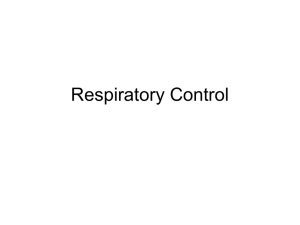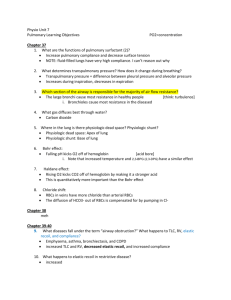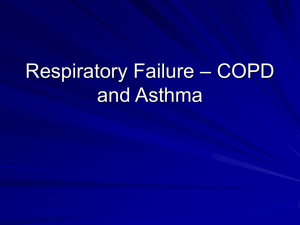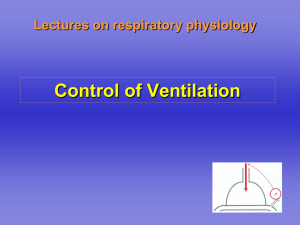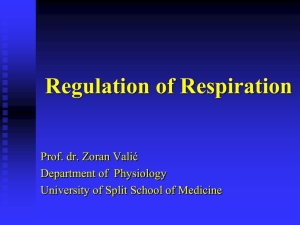dorsal respiratory center
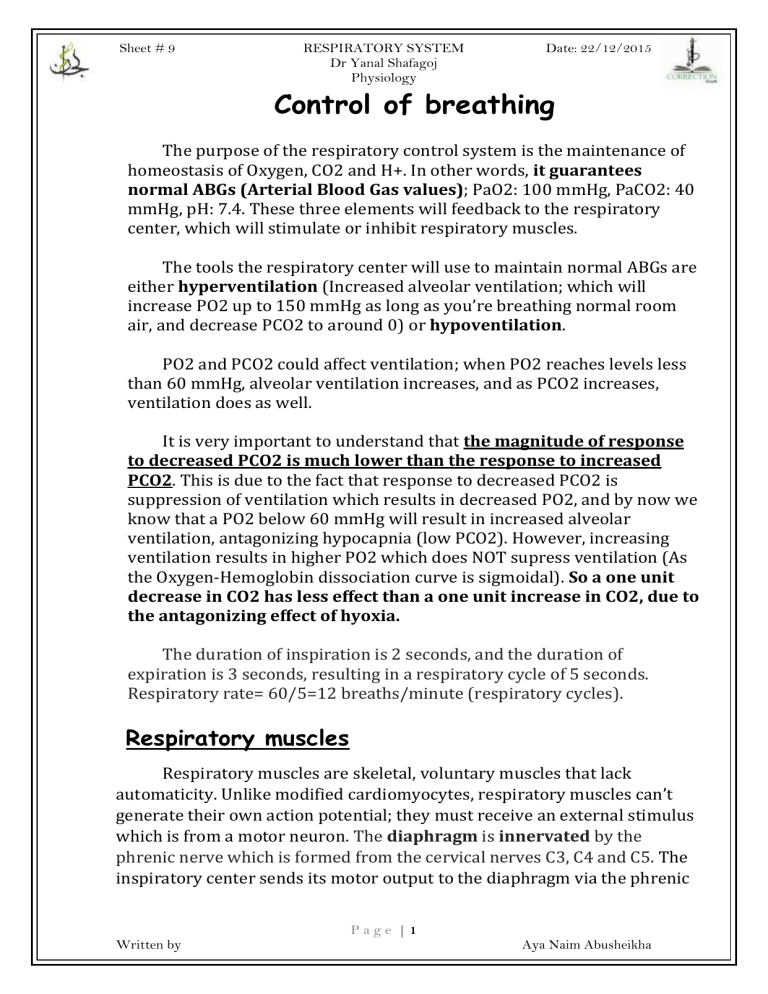
Sheet # 9 RESPIRATORY SYSTEM
Dr Yanal Shafagoj
Physiology
Date: 22/12/2015
Control of breathing
The purpose of the respiratory control system is the maintenance of homeostasis of Oxygen, CO2 and H+. In other words, it guarantees
normal ABGs (Arterial Blood Gas values); PaO2: 100 mmHg, PaCO2: 40 mmHg, pH: 7.4. These three elements will feedback to the respiratory center, which will stimulate or inhibit respiratory muscles.
The tools the respiratory center will use to maintain normal ABGs are either hyperventilation (Increased alveolar ventilation; which will increase PO2 up to 150 mmHg as long as you’re breathing normal room air, and decrease PCO2 to around 0) or hypoventilation.
PO2 and PCO2 could affect ventilation; when PO2 reaches levels less than 60 mmHg, alveolar ventilation increases, and as PCO2 increases, ventilation does as well.
It is very important to understand that the magnitude of response to decreased PCO2 is much lower than the response to increased
PCO2. This is due to the fact that response to decreased PCO2 is suppression of ventilation which results in decreased PO2, and by now we know that a PO2 below 60 mmHg will result in increased alveolar ventilation, antagonizing hypocapnia (low PCO2). However, increasing ventilation results in higher PO2 which does NOT supress ventilation (As the Oxygen-Hemoglobin dissociation curve is sigmoidal). So a one unit decrease in CO2 has less effect than a one unit increase in CO2, due to the antagonizing effect of hyoxia.
The duration of inspiration is 2 seconds, and the duration of expiration is 3 seconds, resulting in a respiratory cycle of 5 seconds.
Respiratory rate= 60/5=12 breaths/minute (respiratory cycles).
Respiratory muscles
Respiratory muscles are skeletal, voluntary muscles that lack automaticity. Unlike modified cardiomyocytes, respiratory muscles can’t generate their own action potential; they must receive an external stimulus which is from a motor neuron. The diaphragm is innervated by the phrenic nerve which is formed from the cervical nerves C3, C4 and C5. The inspiratory center sends its motor output to the diaphragm via the phrenic
Written by
P a g e | 1
Aya Naim Abusheikha
Sheet # 9 RESPIRATORY SYSTEM
Dr Yanal Shafagoj
Date: 22/12/2015
Physiology nerve, so phrenic neurons need input from higher centers (doesn’t have the intrinsic ability to generate action potential)
Brain stem control of breathing
1.
Medullary respiratory center:
The brain stem is the posterior part of the brain, it’s formed by 4 regions, and its last part, the medulla oblongata, is continuous with the spinal cord.
The medulla is composed of two collections of neurons that are distinguished by their anatomic location: Dorsal respiratory neurons
(inspiratory neurons) and Ventral respiratory neurons (expiratory + inspiratory neurons).
During quiet breathing, the dorsal group is the group of neurons responsible for stimulation of phrenic neurons. On the other hand, the ventral group only plays a role in forced inspiration or expiration.
Now take a look at this figure from Costanzo:
As illustrated by the figure above, the dorsal respiratory group is under the control of multiple other accessory centers:
Pneumotaxic center: found in the upper third of the pons (which is located above the medulla), and is the switch off for the dorsal respiratory neurons.
Apneustic center: found in the lower third of the pons, and is the switch on for the dorsal respiratory neurons ( read only: Stimulation of these
Written by
P a g e | 2
Aya Naim Abusheikha
Sheet # 9 RESPIRATORY SYSTEM
Dr Yanal Shafagoj
Date: 22/12/2015
Physiology neurons apparently excites the inspiratory center in the medulla, prolonging the period of action potentials in the phrenic nerve, and thereby prolonging the contraction of the diaphragm.)
2.
Chemoreceptors:
Peripheral chemoreceptors
:
As the name indicates, they’re part of the peripheral nervous system and they detect changes in chemical concentrations (of O2, CO2 and H+).
These chemoreceptors are located in the carotid and aortic bodies which are found at the carotid and aortic arteries
(exact location wasn’t mentioned by the doctor but the picture on the right will help clarify things a bit) and relay information regarding ABG values to the dorsal respiratory center through
CN IX (carotid bodies) and X (aortic bodies). Don’t confuse carotid and aortic bodies with carotid and aortic sinuses which contain baroreceptors that sense the blood pressure.
Structure of carotid and aortic bodies: these bodies are composed of cells very similar structurally to neurons ( read only: these cells are called Type 1 Glomus cells and are derived from the neural crest.
) The cluster of cells is infiltrated with capillaries to provide access to the bloodstream, and these cells are innervated by afferent nerve fibres leading back to the dorsal respiratory center in the medulla (through
CN IX and X). https://www.youtube.com/watch?v=cJXY3Cywrnc
Carotid and aortic bodies have their own blood supply and venous drainage. The chemoreceptor cells aren’t in direct contact with the arterial blood, they’re only in contact with the interstitium so HOW will this cell be able to sense ABGs and relay them to the brain?!
Well actually, interstitial and arterial compositions are almost equal (in order for chemoreceptor cells to sense arterial pO2 not capillary or venous pO2.)
Written by
P a g e | 3
Aya Naim Abusheikha
Sheet # 9 RESPIRATORY SYSTEM
Dr Yanal Shafagoj
Date: 22/12/2015
Physiology
Blood flow is very high so that a very little amount of oxygen is extracted, which means the partial pressure of oxygen does not drop significantly as blood is passing through the carotid body. As blood passes through the carotid body, its composition remains arterial; the arteriovenous (A-V) O2 difference is very minimal. In the heart, the A-
V difference is around 11mL (which means the heart extracts most of the Oxygen delivered to it, that’s why ischemia is very dangerous), in skeletal muscles it’s 5ml (this is the extraction ratio; arterial is 20 and venous is 15: 20-15=5). However, in carotid bodies, the A-V O2 difference is only 0.5 mL (Arterial: 20, Venous: 19.5).
Blood flow to these bodies is huge and enormous. In fact, they have the highest blood flow per gram of tissue in our bodies (20 mL of blood/gram tissue weight), and their weight is actually 25-30 milligram yet they have their own artery. After that come the kidneys
(4 mL/ gram tissue weight). Skeletal muscles have a blood flow of
0.003 mL/gram tissue weight).
Minimizing A-V difference could be done by one of two ways:
1) If those cells are metabolically inactive, they won’t consume
Oxygen, so whatever Oxygen is delivered to these is going to be the same after blood passes by them. However, carotid body cells are the most active cells in our body, so this method won’t work with Carotid bodies, which takes us to the second point.
2) High amounts of Oxygen available due to very high blood flow.
Keep in mind that carotid bodies are sensitive to PO2 lower than 60 mmHg, but not to PO2 higher than 100 mmHg. They’re also sensitive to increased H+ (acidosis) or increased PCO2 (hypercapnia), but when compared to central chemoreceptor sensitivity, peripheral chemoreceptor sensitivity is only one seventh that of the central, but five times faster. (From
Costanzo: The peripheral chemoreceptors also detect increases in PCO2, but the effect is less important than their response to decreases in PO2. Detection of changes in PCO2 by the peripheral chemoreceptors also is less important than detection of changes in PCO2 by the central chemoreceptors.)
-Note: if we denervate or remove the carotid bodies (which send their impulses through vagus nerve (aortic bodies) and glossopharngyeal nerve
(carotid bodies)), and increase CO2 in the blood, we almost see the same effect in hyperventilation after canceling the peripheral chemoreceptors.
Peripheral chemoreceptors do response to H+ but only 15% of the central effect but 5 times faster.
Written by
P a g e | 4
Aya Naim Abusheikha
Sheet # 9 RESPIRATORY SYSTEM
Dr Yanal Shafagoj
Date: 22/12/2015
Physiology
Central chemoreceptors: located in the medulla and are adjacent to the inspiratory center. Even though H+ ions can’t cross the bbb
(charged), central chemoreceptors are sensitive to H+ concentrations.
How? Well CO2 molecules aren’t polar, meaning there are no biological barriers for CO2, meaning CO2 is permeable across the bbb.
Now picture the following scenario:
We ask someone to hold his breath (The cerebral cortex, which is known to control voluntary respiration, will send impulses through the corticospinal tract, directly inhibiting phrenic neurons.)
decreased ventiliation decreased PO2 (100 to 80 mmHg, which means this decrease won’t be sensed by any neuron –recall Oxygen haemoglobin dissociation curve) and increases PCO2 (the maximum PCO2 you could achieve is
50mmHg) CO2 crosses the CSF, combines with H2O forming H2CO3
H2CO3 dissociates into HCO3 and H+ H+ stimulates the chemosensitive area (central chemoreceptors) stimulation of dorsal respiratory neurons
stimulate the phrenic nerve (stronger stimulation that overcomes the inhibition) diaphragm contraction occurs.
The scenario above explains 2 points: 1) It’s impossible for anyone to commit suicide by holding their breath and 2) CO2 is the main controller of the respiratory center through H+, which means that if someone had acidosis without increased CO2 levels, it takes a long time for the H+ ions to enter the CSF.
Written by
P a g e | 5
Aya Naim Abusheikha
Sheet # 9 RESPIRATORY SYSTEM
Dr Yanal Shafagoj
Physiology
Date: 22/12/2015
Responses to exercise
Ventilation increases, but is NOT driven by ABG values. PaO2 remains
100 mmHg (once oxygen consumption increases, ventilation increases as well) and PaCO2 remains 40 mmHg. The impulses which go to the working muscles also go to the dorsal respiratory neurons to drive ventilation. The moving muscles send feedback to the dorsal respiratory neurons to make them work even more. The moving joints and tendons further command the inspiratory center to increase the inspiration rate (if a person has coma and he moved his leg, hyperventilation occurs and it’s driven by the moving joints and muscles.) It’s everything that drives ventilation except the ABGs.
From Guyton: The brain, on transmitting motor impulses to the exercising muscles, is believed to transmit at the same time collateral impulses into the brain stem to excite the respiratory center. Actually, when a person begins to exercise, a large share of the total increase in ventilation begins immediately on initiation of the exercise, before any blood chemicals have had time to change. It is likely that most of the increase in respiration results from neurogenic signals transmitted directly into the brain stem respiratory center at the same time that signals go to the body muscles to cause muscle contraction.
Adaptation to high altitudes
If PO2 decreases below 60 mmHg, peripheral chemoreceptor stimulation occurs (recall that peripheral chemoreceptors are most sensitive to hypoxia), which stimulates the inspiratory center to initiate hyperventilation. So you’re hyperventilating to add Oxygen, but you’re also losing CO2, resulting in alkalosis.
Henderson-Hasselbalch equation: pH = 6.1 + log [HCO3-]/ 0.03 PCO2
= 6.1 + log 24 mmol/ (40 mmHg * 0.03)
=6.1 + log (24/1.2)
=7.4
Written by
P a g e | 6
Aya Naim Abusheikha
Sheet # 9 RESPIRATORY SYSTEM
Dr Yanal Shafagoj
Date: 22/12/2015
Physiology
6.1 is the dissociation constant of carbonic acid. For the CO2 we multiply by 0.03 (conversion factor) to convert mmHg to millimoles. This equation shows us how when CO2 increases, pH decreases.
Ascent to high altitudes increases ventilation because of hypoxia (which results from the decreased PO2 of the inspired air), but it’s antagonized by the resulting alkalosis (due to washing out of CO2). Kidneys, on the other hand, compensate slowly; it takes 3 to 5 days for bicarbonate excretion in the urine by the kidneys to occur (kidneys usually retain HCO3-). So when both CO2 and HCO3- are decreased, pH goes back to normal; so after 5 days you’d end up with low CO2 in the blood but never low pH. Central suppression will be removed, and you’re left with peripheral stimulation and therefore your ventilation is increasing to the maximum at that level (4-
5 times normal).
When you descend, there’s no hypoxia, so there’s no peripheral stimulation and your ventilation is going to decrease. Decreased ventilation means accumulation of CO2 resulting in decreased pH leading to acidosis.
Acidosis occurs due to CO2 accumulation while bicarbonate levels are still low (The kidneys need at least a couple of days to go back to normal).
Normally, the kidney does not excrete bicarbonate at all. When you descend from a high place, not only will the kidney not excrete bicarbonate, it will produce its own bicarbonate until bicarbonate levels become normal again.
The end
Past paper questions:
(
The answers are from the website not me
)
1) Which of the following will return toward normal few weeks following ascending to high altitude (and stay at the top of the mountain)?:
Arterial hydrogen ion concentration
Arterial carbon dioxide tension
Arterial bicarbonate ion concentration
Arterial hemoglobin concentration
Alveolar ventilation
Written by
P a g e | 7
Aya Naim Abusheikha
Sheet # 9 RESPIRATORY SYSTEM
Dr Yanal Shafagoj
Date: 22/12/2015
Physiology
2) Which of the following is most likely cause of a high arterial PCO2?
o Increased metabolic activity during exercise
o Increased alveolar dead space volume
o Depressed medullary respiratory centers
o Alveolar capillary block
o Increased alveolar ventilation
3) What happens to arterial blood gases after a period of hyperventilation: >>> increase Po2, decrease Pco2, no change
PH2o
4) Hyperventilation can result from: a- increase alveolar Pco2
b- increase alveolar Po2
c- decrease arterial Pco2 below 30 mmHg Lejan 2009/2010
d- direct stimulation of central chemosensitive receptors due to increase PH
e- a decline of arterial Po2 from 100 mmHg to 70 mmHg
BRS Physiology questions:
19) Hypoxemia produces hyperventilation by a direct effect on the:
(A) phrenic nerve (B) J receptors (C) lung stretch receptors (D) medullary chemoreceptors (E) carotid and aortic body chemoreceptors
20) Which of the following changes occurs during strenuous exercise?
(A) Ventilation rate and O2 consumption increase to the same extent (B)
Systemic arterial Po2 decreases to about 70 mm Hg (C) Systemic arterial
Pco2 increases to about 60 mm Hg (D) Systemic venous Pco2 decreases to about 20 mm Hg (E) Pulmonary blood flow decreases at the expense of systemic blood flow
25. A 38-year-old woman moves with her family from New York City
(sea level) to Leadville Colorado (10,200 feet above sea level).
Which of the following will occur as a result of residing at high altitude?
(A) Hypoventilation (B) Arterial Po2 greater than 100 mm Hg (C)
Decreased 2,3-diphosphoglycerate (DPG) concentration (D) Shift to the
Written by
P a g e | 8
Aya Naim Abusheikha
Sheet # 9 RESPIRATORY SYSTEM
Dr Yanal Shafagoj
Date: 22/12/2015
Physiology right of the hemoglobin–O2 dissociation curve (E) Pulmonary vasodilation (F) Hypertrophy of the left ventricle (G) Respiratory acidosis
Answers and explanations:
19. The answer is E [VIII B 2]. Hypoxemia stimulates breathing by a direct effect on the peripheral chemoreceptors in the carotid and aortic bodies. Central (medullary) chemoreceptors are stimulated by CO2 (or
H+ ). The J receptors and lung stretch receptors are not chemoreceptors.
The phrenic nerve innervates the diaphragm, and its activity is determined by the output of the brain stem breathing center.
20. The answer is A [IX A]. During exercise, the ventilation rate increases to match the increased O2 consumption and CO2 production. This matching is accomplished without a change in mean arterial Po2 or Pco2.
Venous Pco2 increases because extra CO2 is being produced by the exercising muscle. Because this CO2 will be blown off by the hyperventilating lungs, it does not increase the arterial Pco2. Pulmonary blood flow (cardiac output) increases manifold during strenuous exercise.
25. The answer is D. At high altitudes, the Po2 of alveolar air is decreased because barometric pressure is decreased. As a result, arterial Po2 is decreased (<100 mm Hg), and hypoxemia occurs and causes hyperventilation by an effect on peripheral chemoreceptors.
Hyperventilation leads to respiratory alkalosis. 2,3-Diphosphoglycerate
(DPG) levels increase adaptively; 2,3-DPG binds to hemoglobin and causes the hemoglobin– O2 dissociation curve to shift to the right to improve unloading of O2 in the tissues. The pulmonary vasculature vasoconstricts in response to alveolar hypoxia, resulting in increased pulmonary arterial pressure and hypertrophy of the right ventricle (not the left ventricle).
Written by
P a g e | 9
Aya Naim Abusheikha
